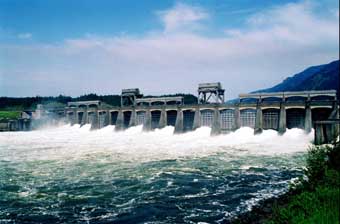forum
library
tutorial
contact

Chinook Salmon Set Fish Count Record
by Associated PressStatesman Journal, December 29, 2003
|
the film forum library tutorial contact |

|
Chinook Salmon Set Fish Count Recordby Associated PressStatesman Journal, December 29, 2003 |
Officials attribute the increased returns at Bonneville Dam to improved ocean conditions and regional recovery efforts.
 PORTLAND -- More than 920,000 chinook salmon passed the Bonneville Dam fish-counting station this year, breaking the 2002 record, according to officials who track the numbers.
PORTLAND -- More than 920,000 chinook salmon passed the Bonneville Dam fish-counting station this year, breaking the 2002 record, according to officials who track the numbers.
According to members of the Federal Caucus — the nine federal agencies participating in salmon recovery
And the number dwarfs the most recent 10-year average of 399,000 salmon.
Similar encouraging adult-return numbers were reported at Bonneville for other species: 364,000 steelhead, 126,000 coho salmon and 39,000 sockeye salmon, with both steelhead and coho well above their 10-year averages.
The fish count season at Bonneville ended on Nov. 15, although counts done via time-lapse video at the fish ladder are still being done during the “off” season.
Even though most of the returns are hatchery-produced fish, biologists said that numbers are increasing for almost all fish in the Columbia Basin, including naturally spawning salmon stocks protected by the Endangered Species Act.
Officials attributed the increased returns to improved ocean conditions and regional salmon-recovery efforts.
“We know that ocean survival and freshwater survival are both critical to salmon,” said Rob Walton, the head of the salmon-recovery division at National Oceanic and Atmospheric Administration Fisheries. “We can’t say for certain how much of the increased survival is due to our efforts, but it appears likely that a number of factors are at work in the region to account for the increasing numbers of salmon in recent years.”
Examples include projects that have protected or improved salmon habitat and passage that have contributed to increased survival of salmon, he said.
“We can’t lose sight of the fact that the historical record tells us that good ocean conditions won’t last forever,” Walton added. “We therefore need to continue to strive for improvements in salmon habitat, survival past the dams, and improved hatchery and harvest practices, in the most cost-effective manner possible.”
Witt Anderson, the chief of the Fish Management Office with the U.S. Army Corps of Engineers, said the increased returns will be further enhanced with the completion of technological improvements being installed at Columbia and Snake river dams.
“These state-of-the-art improvements — a channel that safely diverts young fish at Bonneville Dam and modified spillways at several dams that improve juvenile fish passage — will further increase survival of juvenile salmon and steelhead,” Anderson said.
There is general agreement among fishery biologists that it is important to capitalize on these big returns by continuing to make conditions better in areas where salmon spawn and their young are raised.
The Federal Caucus members include the U.S. Army Corps of Engineers, Bonneville Power Administration, Bureau of Indian Affairs, Bureau of Land Management, Bureau of Reclamation, Environmental Protection Agency, Fish and Wildlife Service, Forest Service and NOAA Fisheries.
learn more on topics covered in the film
Staff
Chinook Salmon Set Fish Count Record
Statesman Journal, December 29, 2003
see the video
read the script
learn the songs
discussion forum
